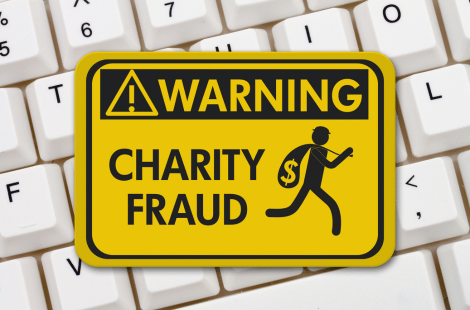
Overview
Charity scams exploit the goodwill of individuals, manipulating their desire to help those in need. These scams involve fraudsters posing as genuine charitable organizations, only to misuse the funds they collect. As charitable donations have transitioned online, the scope and sophistication of these scams have grown, making it essential to recognize and counteract them.
Brief History
Charity scams have existed as long as charitable donations have. Historically, fraudsters might have posed as collection agents for churches or local groups. With global events like natural disasters or pandemics receiving worldwide attention, the digital age has seen a surge in fake charities capitalizing on these crises.
Types of Charity Scams:
1. Fake Charity Organizations:
-
- Description: These are entirely fictitious entities created with the sole purpose of defrauding potential donors.
- Modus Operandi: Scammers might set up professional-looking websites, complete with fake testimonials, photos, and mission statements. They may also send out mass emails or make cold calls soliciting donations.
- Example: A fake charity named “Save the Polar Bears” might claim to work towards saving polar bears from extinction but has no actual operations or initiatives in place.
2. Impersonation of Real Charities:
-
- Description: Here, scammers use names strikingly similar to legitimate, well-known charitable organizations to confuse potential donors.
- Modus Operandi: By slightly altering the name or logo of a recognized charity, they can mislead donors into thinking they’re contributing to a genuine cause.
- Example: Instead of “Save the Children,” a scammer might create a website for “Saving the Children Foundation.”
3. Crowdfunding Scams:
-
- Description: With the rise of platforms like GoFundMe and Kickstarter, there’s been an uptick in fake stories or causes aimed at soliciting donations.
- Modus Operandi: Scammers create compelling, often heartbreaking stories to lure in donors. These stories might revolve around medical emergencies, personal tragedies, or other sympathetic events.
- Example: A user might claim they need funds for a child’s urgent surgery, complete with pictures and detailed narratives, but in reality, there’s no child or surgery.
4. Disaster-Related Charity Scams:
-
- Description: These scams emerge in the wake of natural disasters or global crises, exploiting the outpouring of sympathy and the desire to help affected individuals.
- Modus Operandi: Scammers quickly set up fake relief funds or charities, often using names that closely resemble legitimate disaster relief organizations.
- Example: After a major earthquake, a scam might emerge under the name “Earthquake Relief for [Affected Country]” even though no such organization exists.
5. Telemarketing Charity Scams:
-
- Description: Scammers call potential donors, posing as representatives from legitimate charities or entirely made-up ones.
- Modus Operandi: Using high-pressure tactics and emotional appeals, they try to get immediate donations over the phone, often asking for credit card details.
- Example: A caller might claim to represent a police charity, asking for donations to support the families of fallen officers.
6. Charity Gift Card Scams:
-
- Description: Scammers sell supposed charity gift cards, claiming the proceeds go to a good cause.
- Modus Operandi: These gift cards are often sold online or in person. While they might look legitimate, the funds don’t go to any charitable cause.
- Example: A scammer might sell gift cards claiming proceeds go to “Children’s Education Fund,” but in reality, the funds are pocketed by the scammer.
7. Street Collection Scams:
-
- Description: Fraudsters pose as charity workers collecting donations on the streets.
- Modus Operandi: Using fake ID badges and collection tins, they approach people in busy areas, asking for cash donations.
- Example: A group might set up a booth in a city center, claiming to collect funds for homeless veterans, even though no such initiative exists.
Techniques Used in Charity Scams:
- Emotional Appeals: Using heart-wrenching images or stories to elicit donations quickly.
- High-Pressure Tactics: Urging immediate donations, claiming it’s a matter of life and death.
- Misleading Websites: Creating professional-looking websites that mimic legitimate charities.
- Social Media Campaigns: Using platforms like Facebook or Twitter to spread their fake campaigns virally.
Warning Signs:
1. Vague Mission Statements and Objectives:
-
- Scam charities often lack clear, specific details about their mission, objectives, and how donations are used.
- Red Flag: If a charity’s website or promotional material is filled with generic platitudes but lacks concrete details about their work, it’s a cause for concern.
2. Pressure to Donate Immediately:
-
- Scammers often create a sense of urgency, suggesting that immediate action is critical.
- Red Flag: Be wary of any charity that pushes for on-the-spot donations, especially if they discourage you from taking time to research or think about the donation.
3. Unusual Payment Methods:
-
- While most legitimate charities offer multiple ways to donate, scammers might insist on non-traditional payment methods.
- Red Flag: Be cautious if a charity asks for donations via wire transfer, gift cards, or in cash. These methods are harder to trace and offer little recourse for donors.
4. Lack of Transparency:
-
- Genuine charities are transparent about their finances and operations.
- Red Flag: If a charity is unwilling to provide detailed financial statements or information about its leadership and operations, it’s a potential warning sign.
5. Unsolicited Contact:
-
- Scammers often reach out to potential victims unsolicited, whether through cold calls, emails, or even door-to-door solicitations.
- Red Flag: Be cautious of charities that contact you out of the blue, especially if you’ve never donated to or heard of them before.
6. No Evidence of Tax-Exempt Status:
-
- Legitimate charities often have tax-exempt status, which they can prove.
- Red Flag: If a charity cannot provide evidence of its tax-exempt status or isn’t listed in official databases of registered charities, it’s a potential red flag.
7. Too Good to Be True:
-
- Some scammers offer incentives that seem too good to be true to entice donations.
- Red Flag: Be skeptical of charities offering high-value rewards, sweepstakes entries, or prizes in exchange for donations.
8. Name Similarities:
-
- Some scam charities use names that sound similar to well-known, legitimate organizations to confuse donors.
- Red Flag: If the charity’s name is slightly different from a well-known organization or if it seems designed to mimic another charity, proceed with caution.
9. Lack of Personalized Information in Solicitations:
-
- Mass emails or letters that lack personalization can be indicative of a scam.
- Red Flag: Generic greetings like “Dear Sir/Madam” or “Dear Donor” in unsolicited communications should raise suspicions.
10. Poor Grammar and Spelling:
-
- Scam communications, especially those originating from non-native speakers, might contain noticeable grammar and spelling errors.
- Red Flag: If a charity’s promotional material, emails, or website has numerous errors, it might indicate a less-than-legitimate operation.
Common Solutions for Prevention:
1. Thorough Research:
-
- Description: Before donating, always conduct a comprehensive investigation into the charity.
- How to Implement: Use trusted charity watchdog sites like Charity Navigator, BBB Wise Giving Alliance, or GuideStar to verify a charity’s legitimacy, financial health, and transparency.
2. Avoid Impulse Donations:
-
- Description: Resist the urge to donate on the spot, especially when faced with high-pressure tactics.
- How to Implement: Take time to think about the donation. If a charity is legitimate, it will welcome contributions at any time, without undue pressure.
3. Use Established Donation Platforms:
-
- Description: Ensure that donations are made through secure, well-known platforms or methods.
- How to Implement: Donate directly through the official website of a recognized charity or use established donation platforms like JustGiving or Network for Good.
4. Check for Tax-Exempt Status:
-
- Description: Legitimate charities often have a tax-exempt status.
- How to Implement: In the U.S., use the IRS’s Tax Exempt Organization Search to verify a charity’s tax-exempt status. In other countries, check with the relevant tax or charity regulatory body.
5. Be Wary of Emotional Appeals:
-
- Description: Scammers often use emotional stories or images to bypass logical thinking.
- How to Implement: While emotional appeals are common in charitable solicitations, always combine empathy with due diligence. Verify the authenticity of the claims made by the charity.
6. Secure Personal and Financial Information:
-
- Description: Never share unnecessary personal or financial details when making a donation.
- How to Implement: Only provide the essential information required for the transaction. Avoid saving credit card details on platforms unless they’re well-established and trusted.
7. Verify Solicitation Authenticity:
-
- Description: If approached by phone, email, or in person, verify the authenticity of the solicitation.
- How to Implement: If contacted by phone, ask for a callback number and research it. For emails, check the sender’s email address and avoid clicking on any links. Instead, visit the charity’s official website directly.
8. Avoid Cash Donations:
-
- Description: Cash donations are hard to trace and offer no proof of transaction.
- How to Implement: Opt for checks or digital payment methods. If writing a check, ensure it’s addressed to the official name of the charity and not an individual.
9. Request Donation Receipts:
-
- Description: Always ask for a receipt when making a donation.
- How to Implement: A legitimate charity will provide a receipt that details the donation amount, date, and the charity’s information. This not only serves as proof of donation but can also be used for tax deductions.
9. Stay Updated on Scam Tactics:
-
- Description: Scammers constantly evolve their tactics, so staying informed is crucial.
- How to Implement: Subscribe to updates from consumer protection agencies or charity watchdog groups. They often release information on current scams and deceptive tactics.
How to Protect Your Customers
1. Educate Customers:
-
- Description: Proactively inform customers about the risks of charity scams.
- How to Implement:
-
-
- Awareness Campaigns: Use bank statements, emails, ATM screens, or mobile app notifications to share information about charity scams.
- Workshops and Webinars: Organize events focusing on financial fraud, including charity scams, to educate customers.
- Online Resources: Create a dedicated section on the bank’s website with information about recognizing and reporting charity scams.
-
2. Enhanced Transaction Monitoring:
-
- Description: Implement systems that can detect unusual transaction patterns related to charitable donations.
- How to Implement:
-
-
- Anomaly Detection: Use AI and machine learning to analyze transaction patterns and detect potential charity fraud.
- Geographic Alerts: Set up alerts for transactions that occur in regions known for high scam activities or to unfamiliar charitable organizations.
-
3. Implement Advanced Verification for Suspicious Transactions:
-
- Description: Add an extra layer of security for transactions that seem out of the ordinary.
- How to Implement:
-
-
- Two-Factor Authentication: For large or unusual charity donations, require customers to verify the transaction through a secondary method, like a phone call or SMS.
- Delay Suspicious Transactions: Implement a short delay for suspicious transactions, giving the bank and customer time to verify the charity’s legitimacy.
-
4. Provide Easy Reporting Mechanisms:
-
- Description: Make it simple for customers to report suspicious activities or seek advice.
- How to Implement:
-
-
- Dedicated Hotline: Offer a 24/7 hotline where customers can report suspicious charities or transactions.
- In-App Reporting: Allow customers to flag and report suspicious transactions directly within mobile or online banking platforms.
-
5. Collaborate with Law Enforcement and Regulatory Bodies:
-
- Description: Strengthen ties with external agencies to combat charity scams effectively.
- How to Implement:
-
-
- Reporting Mechanisms: Establish protocols for reporting confirmed cases of charity scams to relevant law enforcement agencies.
- Joint Awareness Campaigns: Collaborate with law enforcement and regulatory bodies to run joint awareness campaigns.
-
6. Offer Support to Victims:
-
- Description: Provide assistance to customers who fall victim to charity scams.
- How to Implement:
-
-
- Counseling Referrals: Offer victims referrals to counseling services to help them cope with the emotional aftermath.
- Financial Advice: Provide sessions with financial advisors to help victims understand their situation and plan their recovery.
-
Real Case Studies:
1. The Hurricane Relief Scam (2017):
-
- Overview: Post-Hurricane Harvey, a fake charity called “Hurricane Relief Fund” was set up.
- How it Happened: The scam used social media to solicit donations, directing to a professional-looking website.
- Aftermath: The scam was uncovered by vigilant netizens who noticed the charity’s recent creation date and lack of verifiable information.
2. The Children’s Leukemia Fund Scam (2015):
-
- Overview: A supposed charity claimed to help children with leukemia.
- How it Happened: Using telemarketing and emotional appeals, they collected millions over several years.
- Aftermath: The U.S. Federal Trade Commission intervened, shutting down the operation and pressing charges.
3. The Global Pandemic Scam (2020):
-
- Overview: Amidst the COVID-19 pandemic, numerous fake charities emerged, claiming to help victims.
- How it Happened: Leveraging global panic and the desire to help, these scams proliferated on social media and via email campaigns.
- Aftermath: Many were shut down, but countless individuals were defrauded in the chaos.







